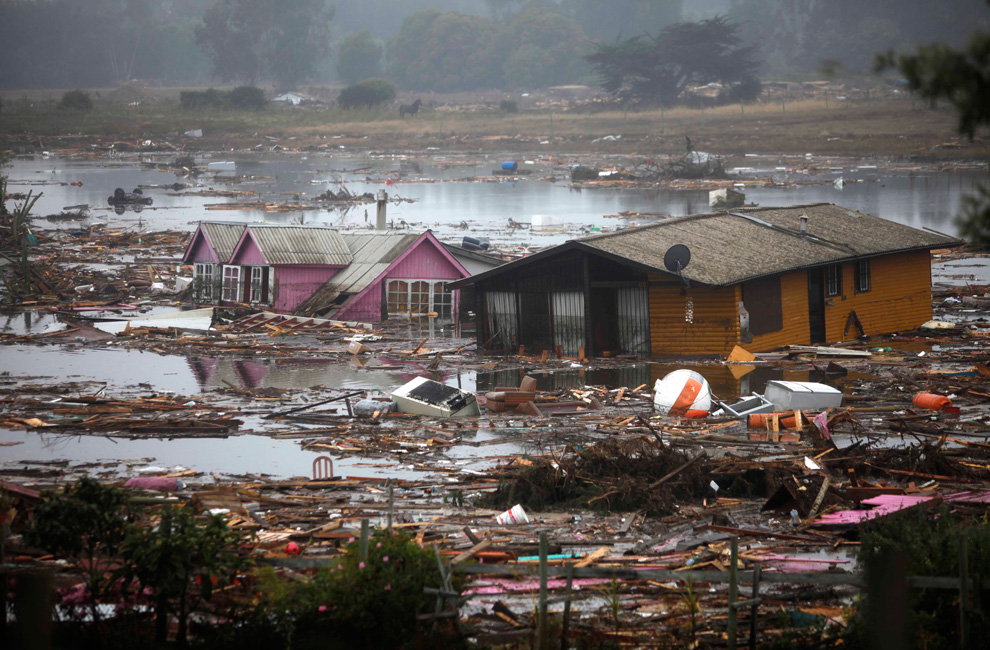Another earthquake, this one 100 times more powerful than the quake that wrecked Haiti. More photographs, although probably less than before due to some combination of better infrastructure in Chile and compassion fatigue in the American media. Comparisons between the two disasters will be made–and sure to include both racist asides and warnings about the Last Days, such are the blessings of free speech. The question remains whether the second quake provides an opportunity to learn something about disasters. Nor is this a question about tectonic plates.

I think this photograph from Pelluhue, some 200 miles southwest of Santiago, is at once typical of the current disaster coverage and yet somewhat distinctive. Typical, in that it documents the nature and extent of the destruction; distinctive, in that the wreckage was done by flooding, a secondary effect of the quake. If nothing else, the photo can prompt one to recognize that this disaster, and every disaster, has more extensive causes and more extensive effects than those seen at the dramatic center of the event.
The photo’s texture may inflect the story further. Instead of the arid, concrete, public, urban environment typically featured in the initial coverage, this rural setting was more lush to begin with and now is awash with the soggy debris of private life. (Yes, those are refrigerators stuck on the strand, and perhaps a buoy for the recreational boating in the area.) It is clear, also, that the disaster has washed up over the land, through no fault of their own, you might say, and that although human domesticity has been disturbed by nature’s excess, a more serene natural world remains, like the horse in the background, awaiting a return to normal activity and dwelling in relative harmony once things are cleaned up and rebuilt. If there is a moral to the story, it is that disasters can have a greater reach than one might expect, but the advice remains the same: be better prepared next time, but get back to normal first. One can almost imagine the scene flowing backwards: the refrigerators moving back into houses, the houses back onto their foundations, the buoy back into the bay, the chairs and buckets back onto the dock, and the flimsy walls of the dockside buildings slapping back together.
Something similar actually will happen, flowing forward, as the aid will come and the investments made and everyone knows what should be the result. Not every disaster zone is so lucky.

This photograph was taken from a helicopter over “a rubble-strewn battlefield” in Marjah, Afghanistan. Note how perfectly, although perhaps inadvertently, the “objective” caption captures the destructiveness so painfully evident in the photo. The three buildings in the picture have effectively ceased to exist, to have ever existed. They are not even mentioned, save to be designated as part of the rubble. (They are another addition to Rubble World, a sector with excellent growth prospects in the 21st century.) As before, the texture of the image speaks powerfully but now with a very different tone: this is sheer desolation, as if the environment had somehow been transformed into war itself, or at least a simulacrum of war suitable for a dark video game. Only one dot of blue remains as the last hint of another purpose for this place of devastation, and soon, if anything is to be done, it will be bulldozed underground.
If anything is to be done. This scene has only the barest trace of a past–shattered concrete without any evident purpose–and virtually no sense of a future. It is a war zone, likely to be leveled for tactical security, and then what? If the armies move on, they leave nothing. If they stay, there is no return to whatever was there before. Likewise, the relationship to other causes and effects remains obscure. The scene was seemingly the center of a battle, but there is no sense of where the war started, why is it there, or where it is going. (This elision of a grand narrative can be a feature of all war photography, as Alan Trachtenberg has noted, but we should add that it may say something about war and have more bite with some wars than others.) War may be more or less destructive than a natural disaster, but only war destroys the future.
There is a political dimension to every natural disaster, but that is not quite my point today. Wars are political disasters, and were we to see them much as we do natural disasters, it might be much easier to help those after the battle and perhaps even to be better prepared to maintain the peace next time. But too often the images of political disasters may, in ways large and small, already be reproducing the damning implication that comes from not being defined as having natural causes. Thus, instead of seeing how calamity has washed over the land through no fault of their own and that there remains only the hard work of rebuilding, the moral of the story is that for those in the wrong place there can be no return to normal life. Earthquakes are episodic, but war and occupation, it seems, are endless.
Photographs by Roberto Candia and Brennan Linsley for the Associated Press.
Cross-posted at BAGnewsNotes.
About earthquake in Chile, check this one
http://www.flickr.com/photos/94686228@N00/4406110927